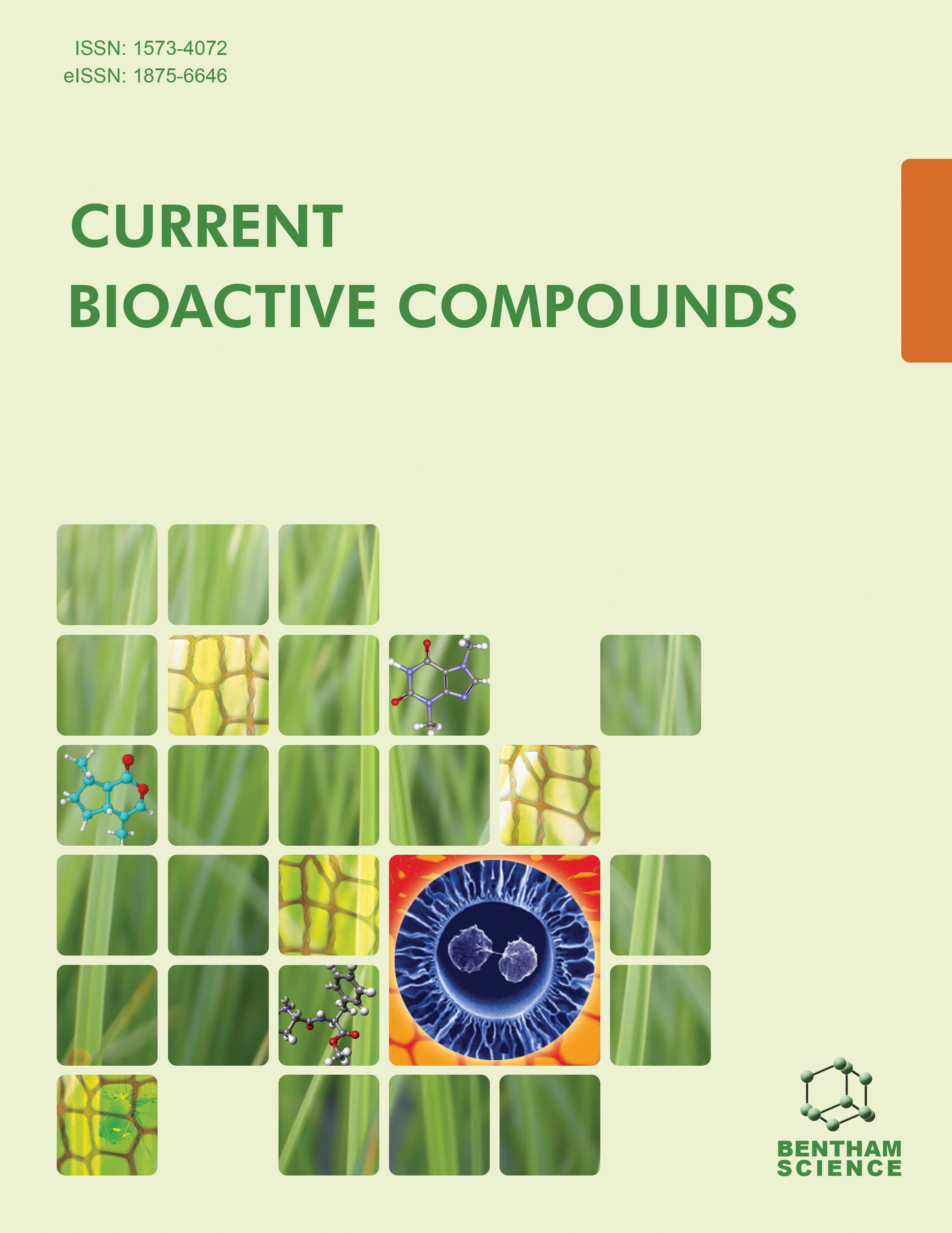- Home
- A-Z Publications
- Current Bioactive Compounds
- Previous Issues
- Volume 20, Issue 10, 2024
Current Bioactive Compounds - Volume 20, Issue 10, 2024
Volume 20, Issue 10, 2024
-
-
Antibacterial Potential of Tetrahydrocarbazoles (THCZ): A Review
More LessAuthors: Nitin Kumar, Shalini Sharma, Saurabh Agrawal and Vishesh VermaAntibiotic resistance has become a major public threat across the globe associated with human health. Some bacterial and fungal infections produce resistance, such as methicillin-resistant Staphylococcus aureus (MRSA), vancomycin-resistant Enterococcus faecium (VRE) and multidrug-resistant (MDR) species Acinetobacter baumannii etc. Tetrahydrocarbazoles (THCz) are a sub-class of indole alkaloids profoundly present Read More
-
-
-
Endophytes: Untapped Source of Antifungal Agents
More LessAuthors: Sudesh Kumari, Prity Gulia, Pooja Choudhary, Namita Sharma, Sweety Dahiya, Aruna Punia and Anil Kumar ChhillarScreening for novel bioactive compounds has become more critical since drug-resistant fungal infections have emerged and ethno-medicinal plants have been embarked as antifungal agents. The emphasis on medicinal plants has recently switched to the study of endophytes and their interactions with the host plant and screening of their antifungal activity. Endophytes are an endosymbiotic group of microorganisms tha Read More
-
-
-
Environment-friendly Simple, and Straight forward Approach Towards the C-4 functionalization of (2S)-5-oxoproline Methyl Ester
More LessAuthors: Sharad Kumar Panday and Munish KumarBackground 4-Substituted- 5-oxo-prolinates (pyroglutamates) are important components in various natural products, e.g. (-)-bulgecinine, (-)-anatoxin, salinosporamide, as well as ACE inhibitors. Aim These also act as important intermediates in the synthesis of many of the bioactive molecules. Due to these reasons, the synthesis of 4-substituted-(2S)-5-oxo-prolinates has received much attention over the globe in the l Read More
-
-
-
A Convenient and Practical Synthesis of Novel Pyrimidine Derivatives and its Therapeutic Potential
More LessAuthors: Kaushal Arora, Amit Kumar and Prabhakar Kumar VermaBackground A new series of 2-(2-(substituted aldehyde)hydrazinyl)-4-(2-chlorophenyl)-1-methyl-6-oxo-1,6-dihydropyrimidine-5-carbonitrile analogs (1–19) was prepared by using the Biginelli reaction. Methods TLC was employed to ensure the progress and confirmation of the reactions. Silica gel G was employed as the stationary phase, and mobile phases such as chloroform: toluene and acetone: n-hexane were used for the synt Read More
-
-
-
Role of Rosmarinus officinalis Aqueous Extract in Relieving the Complications Associated with Ethylene Glycol-induced Urolithiasis in Male Rats
More LessAuthors: Doaa S. Foda, Heba-tollah M. Sweelam and Noha E. IbrahimBackground Rosmarinus officinalis is considered one of the famous plants from ancient times for its therapeutic ability in many diseases, such as headache, spasms, brain disorders, and some pathological conditions associated with toxicity cases in the liver and kidneys. Aim The current research has aimed, for the first time, to evaluate anti-urolithiatic effect of Rosmarinus officinalis aqueous extract (RMAE) on calcium ox Read More
-
-
-
In-vitro Interactions between Fluconazole and Diphenyl Diselenide against Various Candida Species
More LessAuthors: Sweety Dahiya and Anil Kumar ChhillarBackground In the immunocompromised population, Candida species are the most aetiologic agents causing severe nosocomial fungal infections. Candida species, irrespective of being commensals in the human microbiome, are the fourth most prevalent source of potentially fatal yeast infections. Monotherapy is frequently employed to treat invasive fungal infections, but sometimes, patients do not favor the monotherap Read More
-
-
-
Recent Progress in Isolating and Purifying Amide Alkaloids from their Natural Habitats: A Review
More LessAuthors: Himanchal Sharma, Divya Pathak and Sachin KumarAlkaloids are nitrogen-containing chemical compounds found in nature. Many alkaloids are heterocyclic in nature. They are nitrogen-based organic compounds with the nitrogen atoms enclosed in a heterocyclic ring. The chemical “pro alkaloid” is derived from the alkyl amines in it. Many ancient people, long before the advent of organic chemistry, recognized that many of these substances have measurable effects on the body's Read More
-
-
-
Anti Urolithiatic and Diuretic Potentiality of Hemidesmus indicus R. Br.
More LessAuthors: Saumya Das, Avijit Mazumder, Smriti Ojha, Deepika Pathak, Himanshu Singh, Pratibha Pandey and Rashmi Saxena PalAim The present study investigated the development of kidney stone formation in animal models involving renal tubular stone formation by ethylene glycol and COX-2 selective inhibitor-induced urolithiasis along with the diuretic potentiality by Lipschitz teston Wistar rats. Background Hemidesmus indicus (H. indicus) R. Br. played a prominent role in various ancient traditional systems of medications and possessed vari Read More
-
-
-
In Vitro and in-silico Anti-diabetic Evaluation of the Combination of Annona squamosa Linn., Leaf Extract and Oleanolic Acid
More LessBackground Diabetes mellitus (DM) is a metabolic disorder caused by insufficient insulin production from pancreatic β-cells or insulin resistance; its prevalence rapidly increases worldwide. Increasing reports indicate that most plant bioactive agents exhibited alternative and safe effects in managing DM. Objective The study aims to evaluate the in vitro antioxidant and anti-diabetic efficacy of the combination of Annona squ Read More
-
Volumes & issues
-
Volume 21 (2025)
-
Volume 20 (2024)
-
Volume 19 (2023)
-
Volume 18 (2022)
-
Volume 17 (2021)
-
Volume 16 (2020)
-
Volume 15 (2019)
-
Volume 14 (2018)
-
Volume 13 (2017)
-
Volume 12 (2016)
-
Volume 11 (2015)
-
Volume 10 (2014)
-
Volume 9 (2013)
-
Volume 8 (2012)
-
Volume 7 (2011)
-
Volume 6 (2010)
-
Volume 5 (2009)
-
Volume 4 (2008)
-
Volume 3 (2007)
-
Volume 2 (2006)
-
Volume 1 (2005)
Most Read This Month
Article
content/journals/cbc
Journal
10
5
false
en

Most Cited Most Cited RSS feed
-
-
Podophyllotoxin: Current Perspectives
Authors: Ying Qian Liu, Liu Yang and Xuan Tian
-
- More Less

